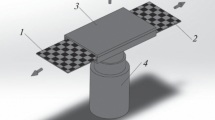Abstract
Fluence-response relationships were examined for positive and negative phototropism induced by blue (450 nm) and ultraviolet-B (UV-B, 280 nm) light, respectively, in the Pilobolus crystallinus sporangiophore. Fluence-response curves for both blue and UV-B light obtained by changing the fluence by varying exposure time only showed the classical first and second positive bending. However, fluence-response curves obtained by varying the fluence rate were bell-shaped irrespective of the length of the exposure time. With increasing exposure time the peak became higher along the ascendant arm and the descendant arm was shifted toward the higher fluence. The Bunsen-Roscoe reciprocity law was valid only when the fluence was less than approx. 400 pmol·m-2 for both blue and UV-B light. Because the shapes of the fluence-response curves for blue and UV-B light were nearly the same, the photoreceptor systems for both blue and UV-B light are considered to be the same.
Similar content being viewed by others
Abbreviations
- UV-B:
-
ultraviolet-B
References
Baskin, T.I., Iino, M. (1987) An action spectrum in the blue and ultraviolet for phototropism in alfalfa. Photochem. Photobiol. 46, 127–136
Blaauw, O.H., Blaauw-Jansen, G. (1970a) The phototropic responses of Avena coleoptiles. Acta Bot. Neerl. 19, 755–763
Briggs, W. R. (1960) Light dosage and phototropic responses of corn and oat coleoptiles. Plant Physiol. 35, 951–962
Dennison, D.S. (1979) Phototropism. In: Encyclopedia of Plant Physiology, N.S., vol. 4: Physiology of movements, pp. 506–566, Haupt, W., Feinleib, M.E., eds. Springer, Berlin Heidelberg New York
Galland, P., Palit, A., Lipson, E.D. (1985) Phycomyces: Phototropism and light-growth response to pulse stimuli. Planta 165, 538–547
Galland, P., Russo, V.E.A. (1985) Tropic reversal in Phycomyces. Planta 163, 401–404
Iino, M., Schäfer, E. (1984) Phototropic response of the stage I Phycomyces sporangiophore to a pulse of blue light. Proc. Natl. Acad. Sci. USA 81, 7103–7107
Kataoka, H. (1977) Second positive-and negative phototropism in Vaucheria geminata. Plant Cell Physiol. 18, 473–476
McVickar, D.L. (1942) The light-controlled diurnal rhythm of asexual reproduction in Pilobolus. Am. J. Bot. 29, 372–380
Jacob, F. (1959) Vergleichende Studien über die phototropische Empfindlichkeit junger Sporangienträger der Gattung Pilobolus. Arch. Protistenk. 103, 531–572
Page, R. (1966) Studies on phototropism of young sporangiophore of Pilobolus kleinii. Photochem. Photobiol. 5, 31–40
Steinitz, B., Poff, K.L. (1986) A single positive phototropic response induced with pulsed light in hypocotyls of Arabidopsis thaliana seedlings. Planta 168, 305–315
Zimmerman, B.K., Briggs, W.R. (1963) Phototropic dosageresponse curves for oat coleoptiles. Plant Physiol 38, 248–253
Author information
Authors and Affiliations
Rights and permissions
About this article
Cite this article
Kubo, H., Mihara, H. Phototropic fluence-response curves for Pilobolus crystallinus sporangiophore. Planta 174, 174–179 (1988). https://doi.org/10.1007/BF00394769
Received:
Accepted:
Issue Date:
DOI: https://doi.org/10.1007/BF00394769




